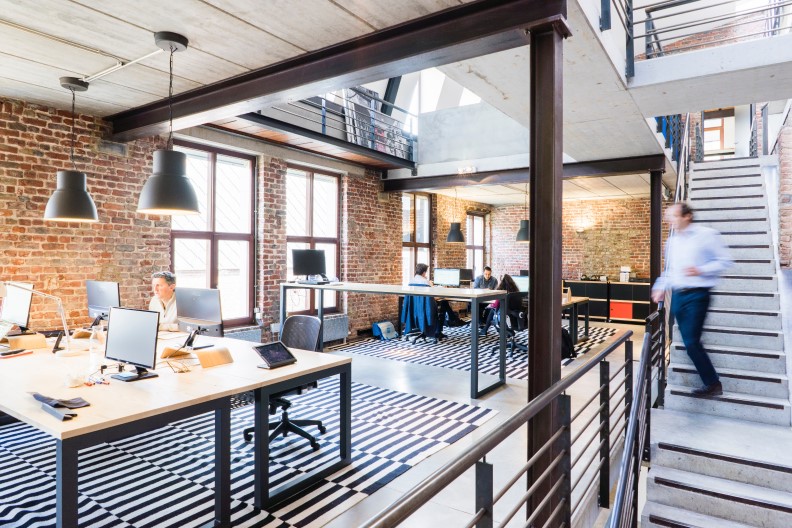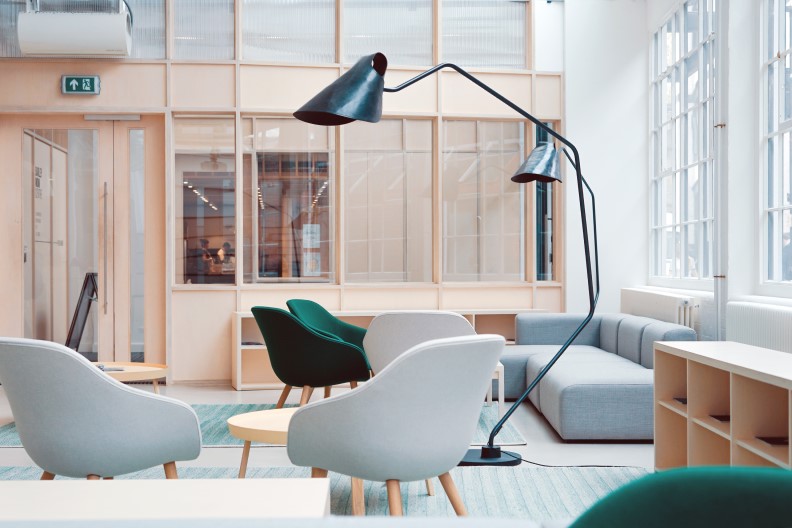2 Ways of Building an Open Space Office with Different Temperature Zones

The ASHRAE Standard 55 defines thermal comfort as “the condition of mind that expresses satisfaction with the thermal environment and is assessed by subjective evaluation.” In other words, thermal comfort involves technical aspects like temperature and humidity, but individual needs and preferences also come into play. In an office building, you can have some occupants suffocating from the heat while others are shivering at the same time.
The relationship between temperature and human performance has been the subject of several studies. For example, the National Renewable Energy Laboratory (NREL) concluded that human productivity peaks at a temperature range of 70-75°F (21-24°C). However, setting the thermostat within this range is not enough: occupants close to air diffusers may still feel cold, while those close to windows may feel hot on sunny days.
When a single thermostat is used for a large office area, finding a temperature that makes everyone comfortable is unlikely. Buildings have internal temperature variations due to the distribution of air diffusers, walls, equipment, occupants and windows. Individual preferences also vary, as previously mentioned.
There are two complementary strategies to achieve thermal comfort:
- Dividing the building into more thermal zones, and providing local temperature controls.
- Giving collaborators the freedom to sit where they feel the most comfortable.
- This could be complemented with a mobile application that displays a thermal map of the office, so occupants can know how the temperature varies indoors.

An uncomfortable office environment makes companies lose money. WELL recommends surveying employees twice a year.
Construction codes establish the minimum performance and design features that are legally required in buildings, while green building certifications strive for enhanced performance. However, the WELL Building Standard is a useful reference for designing healthy and productive interiors. Its certification system focuses on persons instead of buildings, and thermal comfort is one of the main aspects covered. The International WELL Building Institute identifies six main factors that determine thermal comfort in indoor spaces:
- Air temperature
- Humidity
- Air movement
- Temperature of surrounding surfaces
- Metabolic rate of each person
- Insulation provided by clothing
Air temperature, humidity and movement can be controlled by the HVAC system. However, the temperature of indoor surfaces varies, while the metabolic rate and clothing insulation are different for each occupant. The age, sex, health and climatological origin of occupants are also identified as secondary factors that affect thermal comfort.
To provide thermal comfort, WELL recommends the two strategies previously described: multiple thermal zones and freedom to choose where to sit. The standard also recommends comfort monitoring and humidity control.
Dividing an Office into Multiple Temperature Zones
When an office building is divided into multiple temperature zones, occupants have two options to feel more comfortable: adjusting the temperature of their zone, or moving freely between different zones.
To keep different indoor temperatures, all thermal zones must have individual sensors and controls. The sensors must be placed away from any source of heat or cold that can disrupt measurements, such as air diffusers, direct sunlight, heat-releasing equipment and windows. WELL recommends placing temperature sensors at least 1 m away from these sources of heat and cold. Having a thermostat for each zone is the conventional approach, but digital control with a smartphone app is also a viable option.

The distribution of air diffusers, walls, equipment, occupants and windows affect the indoor temperature variation.
On average, an overheated office suffers a performance loss of 6%, while a cold office suffers a performance drop of 4%. Assuming a 50,000 sq.ft. office and applying the 3-30-300 rule from Jones Lang LaSalle:
- A 6% performance loss represents $900,000 per year
- A 4% performance loss represents $600,000 per year
Studies by NREL and other research institutions have determined that thermal comfort improves productivity. In a large office building, the savings from higher productivity are significant. The WELL standard recommends a thermal comfort survey for occupants, twice per year.
Improving Thermal Comfort with Free Address
Separating an office building into many temperature zones gives more comfort options for occupants. However, the benefits of this feature are limited when collaborators have a fixed desk in the office. For example, if two persons with very different preferences sit close together, it may be difficult for them to agree on a thermostat setting.
With free address, collaborators can choose the spot that maximizes their thermal comfort. This becomes easier if they are provided with an app that displays the variation of indoor temperature. An application can display a color-based “heat map”, which is based on temperature measurements throughout the interior space. This way, occupants can move to where they feel more comfortable.
The WELL standard recommends a temperature variation of at least 5°F (3°C) for open workspaces larger than 2,150 sq ft, between rooms with more than 10 occupants, or between different floors.
Complementary Features to Enhance Thermal Comfort
Radiant heating and cooling systems have been linked with improved thermal comfort, since they produce a more uniform heat distribution in building interiors. Radiant systems also provide heating and cooling directly from walls and floors, instead of using air circulation. The temperature of indoor surfaces has been identified among the main factors that influence thermal comfort, and radiant systems take advantage of this.
- Hydronic radiant systems use pipes embedded in walls and floors, and they can provide either heating or cooling, by circulating either hot water or chilled water.
- Electric radiant systems use electric resistance, as implied by their name. They are also installed on walls and floors, but they can only provide heating.
On average, an overheated office suffers a performance loss of 6%, while a cold office suffers a drop of 4%. Assuming a 50,000 sq.ft. office and applying the 3-30-300 rule from JLL, those losses translate into $900,000, and $600,000 per year, respectively.
The main drawback of radiant systems is their high upfront cost, since piping or electric resistance panels must be embedded in walls and floors. However, radiant systems also improve indoor air quality – since they don’t use forced air circulation, they don’t spread dust and other air particles. Radiant heating separates ventilation from heating and cooling, allowing both systems to be optimized separately.
Another viable measure to improve thermal comfort is implementing a flexible dress code. Since clothing insulation is one of the main factors that affect thermal comfort, a flexible dress code gives more options for collaborators.
The interaction between humidity and temperature affects thermal comfort, and the WELL standard recognizes this. According to ASHRAE, the ideal relative humidity range for human health and comfort is 30 to 60 percent.
Conclusion
Salaries are a much larger expense than rent and utility services in a typical office building. Increasing productivity is in the best interest of companies, and research institutions like NREL have found that productivity is strongly affected by thermal comfort. In other words, an uncomfortable office environment makes companies lose money.
Thermal comfort is subjective, but it also depends on measurable aspects like indoor temperature and air humidity. Building owners should invest in an HVAC system that keeps these variables within a comfortable range, while being more flexible with employees. A company can use many thermal zones where collaborators can choose where to sit, while easing the dress code to provide more clothing options.
An HVAC system that uses a single thermostat and a single thermostat for the whole office may seem like a cheaper option upfront. However, the productivity loss due to discomfort will outweigh the upfront savings by far, based on the JLL 3-30-300 rule.

Indoor comfort and energy savings on autopilot
Thermal comfort and indoor air quality are very correlated to staff health and cognitive performance, studies say.
Since human resources are businesses’ largest expense, it’s time to give them the best.